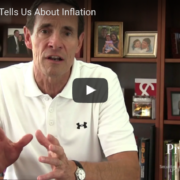Correcting the Word: Correction
The markets are off to a rough start for 2022, with the S&P 500 down about 13.9 percent from its peak in January, according to data from LPL Financial. Global turmoil, inflation, supply chain disruption, and the Federal Reserve are all supposedly to blame. The media pundits call moments like these a “correction,” which is typically defined as a broad market drop of greater than 10 percent but less than 20 percent, according to Charles Schwab. I’ve always had an issue with that definition.
By definition, a correction means the current price for something is incorrect and needs to be “corrected.” Furthermore, it always seems to imply that the price is too high and needs to be corrected lower. As a long-term investor, this doesn’t make much sense.
Expanding on our example above, the S&P is down about 14 percent this year. But since 1980, the average correction per year has been right at 14 percent. Twelve of the last 21 corrections during that time period resulted in the S&P fully recovering and finishing in the green. Looking at the statistics, I would argue that the correction is usually incorrect from the start.
This example points to a subtle but important difference in how we value equities as investors. At any time and from nearly any device, an investor can check the “price” of a current stock. This price is in constant fluctuation and is largely the result of everything the market knows (or thinks it knows) about that stock at that moment in time.
Let’s look at this from a price versus value perspective. For example, suppose Company ABC releases earnings that show increased sales. The stock likely goes up. On the other hand, if Company ABC’s president has been embezzling funds, the stock probably goes down. Regardless, the price is the numeral equivalent of everything currently known about a stock.
The “value” on the other hand, is more difficult to pin down. If the price is what a stock is selling for right now, the value could be stated as what we believe the stock should be selling for in the future.
Company ABC has been working on a revolutionary cancer treatment. As an investor, we have the choice to believe they will either succeed or fail. This belief, at its core, will help us decide whether to invest in the company. There’s no way of knowing what the outcome will be, but our objective as investors is to understand the reasoning and justification for our position or to simply avoid the investment altogether.
The price of a stock is constantly moving, but a belief about the company’s true value may change much more slowly.
Think about it this way – when we purchase a stock, we’re met almost immediately with judgment about our decision. Moments after buying, did the stock go up or down? How about ten minutes later? At the end of the day? End of the week? Too often, this intermittent dopamine hit incorrectly steers our internal judgment about having made the investment. If I bought ABC stock at $5, and two weeks later, it’s at $6, I feel like a genius! But three months later, it’s at $4, and now the feelings of regret start to set in. That’s why it’s crucial to think about the true value of an investment before you make it.
Let’s return to our earlier example of Company ABC and their new cancer treatment. What would the market look like if they were successful? How does their company compare to the competition? Would they capture new market share and higher sales? Would this new treatment have a significant enough impact on raising their share price? If so, what do you think the share price could be?
That last question is very important. Too often, we see investors simply throw money at an investment, thinking “it will go up.” That may be true, but how will you know when to sell? When will it have gone up enough or be overvalued? When we consider only the price, we’re a ship lost at sea. With no reference point, no idea of which way is north or south, it’s impossible to know if it’s the right time to buy or sell any given stock.
That’s why correction is a terrible word to use for these brief drops in price. The word in and of itself insinuates that stocks were overpriced all along, which simply isn’t true when considering a period greater than “right now.” When prices recover and start to climb again, as they often do, no one proclaims that the stock market is in a correction again. But, by definition, can’t prices correct upward toward a higher value? When markets present businesses at prices below what we believe the business is worth, we call that an opportunity.
We discourage investors from watching the daily fluctuations of price. Before investing in any given company, ask yourself what you think the price of the stock should be and why. Don’t settle on the idea that it will simply go up; instead, pick an actual number, and ask yourself why that number. This exercise will help give a reference point and help you to tolerate the volatility that comes with investing. It can help you decide when to buy more or consider selling your investment. It may indeed help you to improve your investor behavior.
Corrections should not simply equate to a broad market drop in prices. Just because a price has gone down, it doesn’t mean it is any more correct than the days or weeks before the drop. Instead, a correction should mean a swift movement in price that puts it more in line with what you believe the true value of the stock should be, whether up or down. So, yes, markets are down from their January peaks, but are prices more “correct” than they were at the start of the year? That’s up for debate.
Steve Booren is the Owner and Founder of Prosperion Financial Advisors, located in Greenwood Village, Colo. He is the author of Blind Spots: The Mental Mistakes Investors Make and Intelligent Investing: Your Guide to a Growing Retirement Income and a regular columnist in The Denver Post. He was recently named a Barron’s Top Financial Advisor and recognized as a Forbes Top Wealth Advisor in Colorado.









